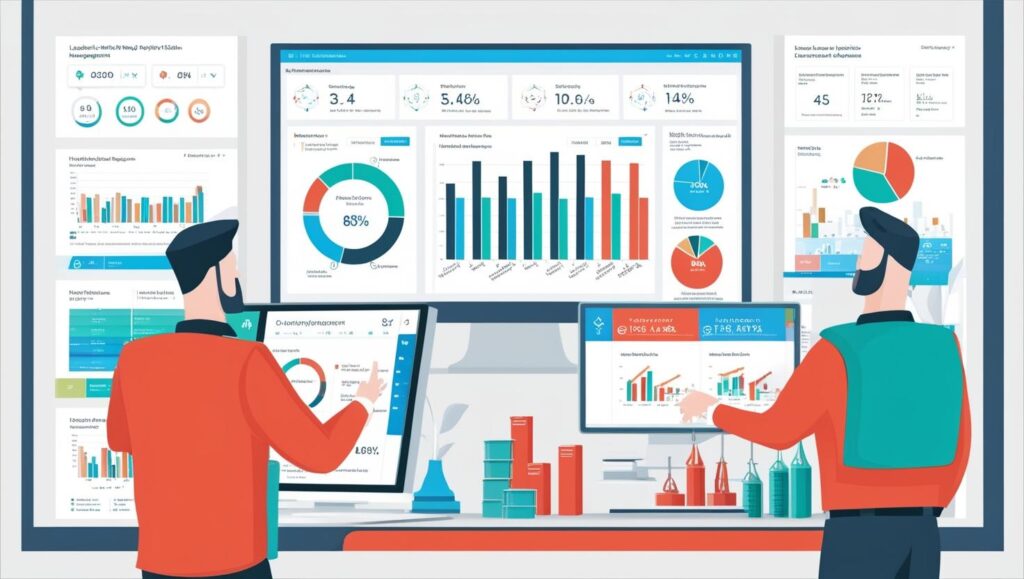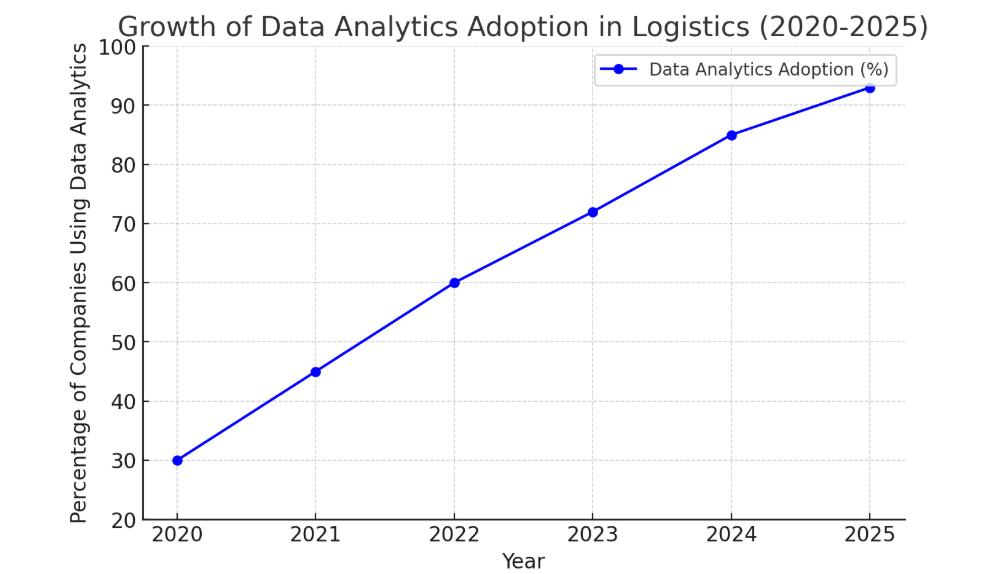What Are Logistics and Supply Chain Management Companies?

Logistics and supply chain management (SCM) companies are responsible for the movement, storage, and distribution of goods from manufacturers to consumers. These companies ensure that raw materials reach production facilities, finished products are delivered to customers, and inventory is maintained efficiently. The goal of logistics and SCM is to optimize operations, minimize costs, and enhance customer satisfaction.
With increasing demand for faster deliveries, better inventory management, and cost reduction, data analytics has become a crucial tool in transforming logistics operations.
Understanding Data Analytics in Logistics and Supply Chain Management
Data analytics refers to the process of collecting, analyzing, and interpreting data to make informed business decisions. In the logistics and supply chain industry, data analytics helps companies optimize processes, reduce costs, and improve efficiency by analyzing real-time and historical data.
By leveraging big data, artificial intelligence (AI), and machine learning (ML), logistics companies can predict demand, optimize delivery routes, manage warehouse inventory, and improve overall supply chain visibility.
Challenges in Logistics and Supply Chain Management
Despite technological advancements, logistics and supply chain management companies face several challenges:
- Monitoring Major and Minor KPIs
Companies struggle to track key performance indicators (KPIs) like on-time delivery rates, transportation costs, inventory turnover, and order accuracy. Minor KPIs such as fuel efficiency, route deviations, and maintenance schedules also impact efficiency but are often overlooked.
- Lack of real-time visibility
Many logistics firms lack real-time tracking of shipments, leading to delays and inefficiencies. Customers demand real-time updates on their shipments, creating a need for advanced tracking systems.
- Inefficient route planning
Without route optimization, companies face higher fuel costs, increased travel time, and poor delivery efficiency.
- Inventory Management Issues
Overstocking or understocking results in lost revenue and higher operational costs. Poor inventory forecasting can disrupt supply chains, leading to lost sales or wasted resources.
- Rising Operational Costs
Fuel price fluctuations, warehouse expenses, and labor costs put pressure on profitability.
- Supply Chain Disruptions
Unforeseen events like natural disasters, pandemics, or geopolitical tensions impact logistics operations.
How Data Analytics Can Revolutionize Logistics and Supply Chain Management
Data analytics offers actionable insights that improve decision-making and operational efficiency. Here’s how it’s transforming the logistics industry:
Predictive analytics detects potential supply chain disruptions and suggests proactive measures.
- Enhancing Real-Time Tracking & Visibility
IoT sensors and GPS tracking enable real-time shipment monitoring and proactive issue resolution.
Customers receive automated alerts for delays, improving transparency.
- Optimizing Route Planning
AI-driven route optimization minimizes fuel costs and delivery time by identifying the best possible paths.
Dynamic routing adjusts based on real-time traffic and weather conditions.
- Improving Inventory Management
Demand forecasting helps businesses reduce overstocking and stockouts.
Smart warehouses use AI-powered robots and IoT sensors for efficient stock tracking.
- Enhancing Cost Reduction Strategies
Companies use analytics to track fuel consumption, fleet maintenance, and warehouse operations to minimize expenses.
- Mitigating Supply Chain Risk
Predictive analytics detects potential supply chain disruptions and suggests proactive measures.
Implementing Data-Driven Strategies in Logistics and Supply Chain Management

To harness the power of data analytics, logistics firms must adopt data-driven strategies for informed decision-making.
- Using an ERP System for Centralized Data Management
Enterprise Resource Planning (ERP) systems integrate various business functions into a single platform:
- Real-time tracking: Monitors fleet movement and alerts customers & suppliers in case of delays.
- Financial analysis: Tracks profits, revenue, and sales data.
- Route optimization: Identifies cost-effective delivery routes.
- Inventory control: Automates stock tracking and replenishment.
2. Data Analysis Using Excel, Python, and Power BI
For companies without ERP systems, Excel, Python, and Power BI provide powerful analytical tools:
- Excel: Organizes data for manual analysis.
- Python: Automates data processing, predictive analytics, and trend forecasting.
- Power BI: Creates interactive reports and dashboards for real-time insights.
3. Outsourcing Data Analytics to Expert Firms
Some logistics firms prefer to outsource data analytics to specialized companies that:
- Analyze market trends and operational data.
- Provide predictive insights to mitigate risks.
- Generate customized reports for decision-making.
Growth in data analytics adoption among logistics firms from 2020 to 2025.

The graph illustrates the growth in data analytics adoption in logistics and supply chain management from 2020 to 2025.
- In 2020, only about 30% of logistics firms were using data analytics to optimize their operations.
- By 2022, the adoption rate had surged to 60%, as companies realized the need for real-time tracking, predictive analytics, and data-driven decision-making—especially after the supply chain disruptions caused by COVID-19.
- By 2024, nearly 85% of logistics firms had implemented some form of data analytics to enhance efficiency and reduce costs.
- In 2025, adoption is projected to reach 93%, meaning that almost all major logistics companies have integrated AI-driven analytics, automation, and predictive modeling into their supply chains.
Why Companies Without Data Analytics in 2025 Are Falling Behind
If your logistics or supply chain management company is not leveraging data analytics in 2025, you are:
❌ Losing competitive advantage – Your competitors are optimizing costs, delivery speed, and efficiency while you rely on outdated methods.
❌ Missing crucial insights – Your data holds valuable information about cost-saving opportunities, customer preferences, and supply chain bottlenecks.
❌ Operating inefficiently – Without route optimization, predictive inventory management, and real-time tracking, your logistics operations are slower and more expensive.
❌ Failing to adapt to industry trends – The world is moving towards AI-driven logistics. Companies that ignore data analytics risk becoming obsolete.
How Data Analytics Acts as a Game-Changer in Logistics
- Predictive Analytics
- The analytics uses historical and real-time data to forecast future events.
- They help to predict demand fluctuations, delivery times, and potential disruptions (e.g., bad weather, supplier delays).
2. Descriptive Analytics
- Examines past data to identify patterns and trends.
- Helps companies analyze customer buying behavior, delivery efficiency, and supplier performance.
3. Diagnostic Analytics
- Determines the cause of past issues in supply chain operations.
- Identifies reasons for delays, inefficiencies, and cost overruns.
4. Prescriptive Analytics
- Recommends the best actions to take based on data insights.
- Helps logistics firms make real-time decisions, optimize routes, and manage inventory levels.
The Future Is Data-Driven
If your logistics company hasn’t adopted data analytics by 2025, you’re already behind. The industry is moving towards automation, AI, and predictive insights, and those who fail to adapt will struggle to compete.
